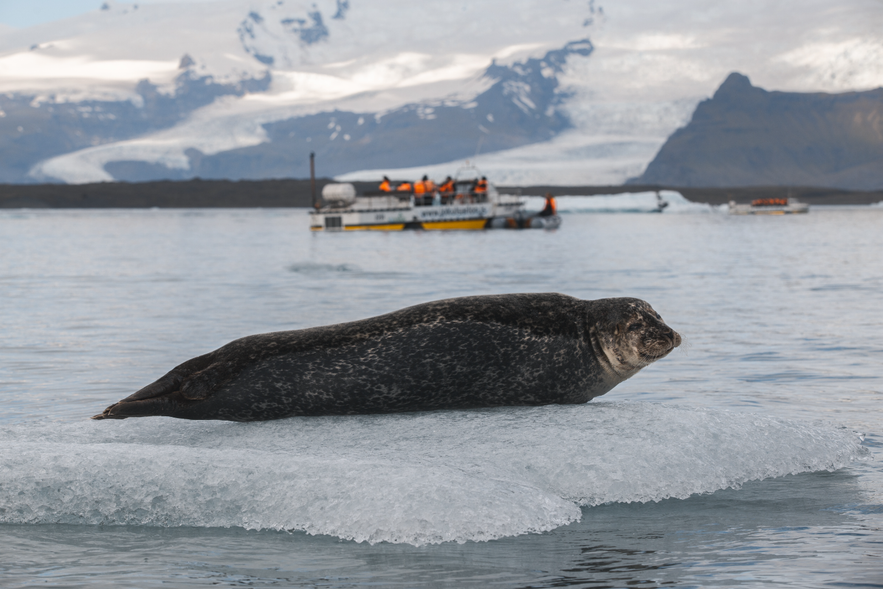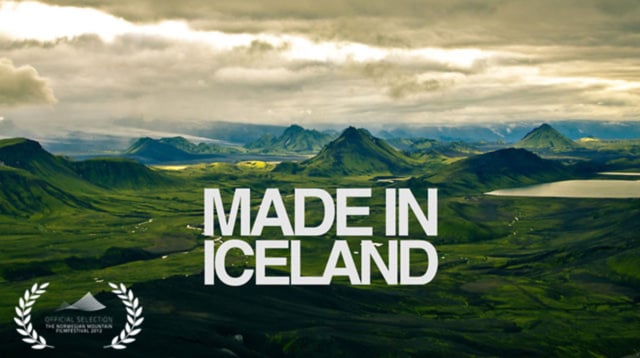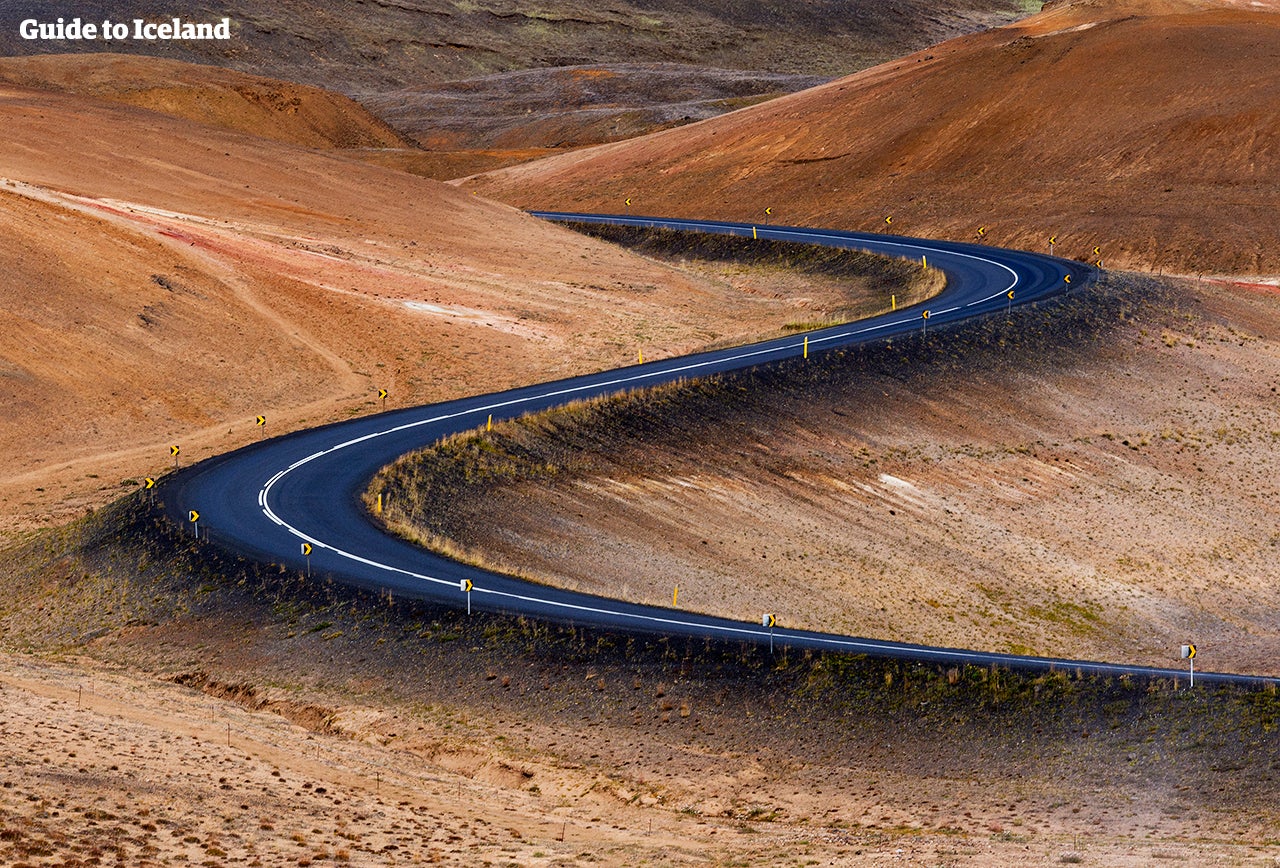Iceland is home to some of the best seal-watching opportunities in the North Atlantic. Read on to learn where to find them, how to watch them without disturbing their habitat, and everything you need to know about seal watching in Iceland.
Seal watching in Iceland offers stunning coastal landscapes and incredible wildlife encounters. Seals are often seen year-round along the country’s shores, so they're often spotted on self-drive tours, with many wildlife tours in Iceland providing great opportunities to observe them up close in their natural habitat.
Why You Can Trust Our Content
Guide to Iceland is the most trusted travel platform in Iceland, helping millions of visitors each year. All our content is written and reviewed by local experts who are deeply familiar with Iceland. You can count on us for accurate, up-to-date, and trustworthy travel advice.
Iceland is home to numerous seal colonies easily spotted in many locations around the country. Harbor seals and grey seals are the most common species, often seen lounging on rocks or swimming near the shore.
Popular viewing spots include the Jokulsarlon Glacier Lagoon, Hvammstangi in the northwest, and the beaches near the Westman Islands. They lounge on rocky shores, dart through glacial waters, and play a major role in local folklore.
This guide has everything you need to know, from the best viewing spots to the latest conservation efforts, ensuring these ocean pups continue to thrive.
Key Takeaways
-
Best Seasons for Seal Watching: The prime time for seal watching in Iceland is from April to October, with the Vatnsnes Peninsula being one of the top locations to see large seal colonies.
-
Respect Wildlife: While seals are fascinating to observe, it's important to keep a safe distance — at least 320 feet (about 100 meters) — to avoid disturbing them. Never attempt to pet or feed seals, as this can harm their natural behavior and health.
-
Environmental Conservation: Iceland is committed to protecting seal populations through initiatives like Green Key certification for eco-friendly tourism.
-
Safe and Sustainable Experiences: Guided tours offer a safe and educational way to observe seals, with expert guides ensuring minimal disturbance to these wild animals and their habitats.
Where To See Seals in Iceland
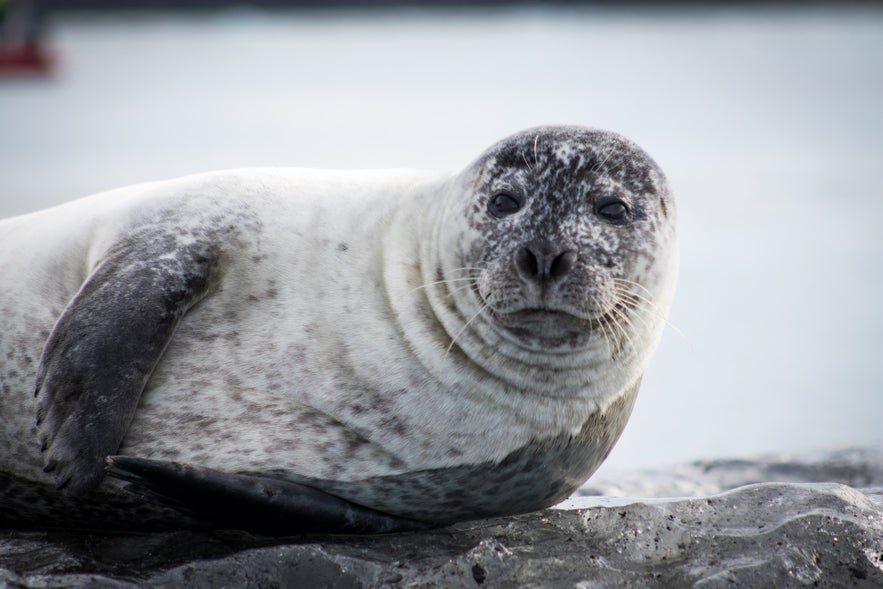
Photo above by Jane Yeo
Imagine standing in a crisp sea breeze on Iceland’s rugged coastline. Out of the corner of your eye, you spot a pair of curious, round eyes peeking above the water. Then a sleek, whiskered face emerges — a seal, as curious about you as you are about it.
Iceland’s rugged coastline, icy lagoons, and remote peninsulas provide the perfect backdrop for observing seals in their natural habitat. Whether lounging on rocky shores or gliding through glacial waters, seals can be spotted year-round in several key locations across the country.
What is the best place to see seals in Iceland? Here are our picks of the best places to see them up close.
Vatnsnes Peninsula: Iceland’s Seal-Watching Capital
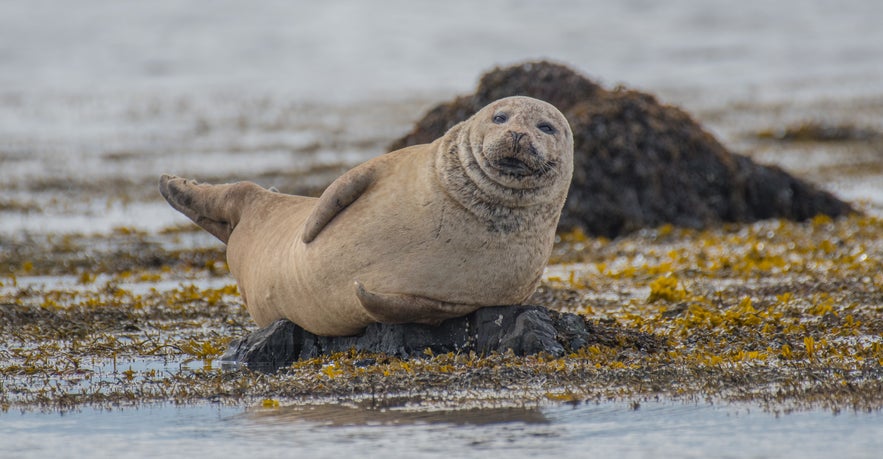
Photo by Pascal Mauerhofer
If there’s one place in Iceland known for exceptional seal watching, it’s the Vatnsnes Peninsula. This northern coastal region is home to some of the country’s largest seal colonies, making it a must-visit for wildlife enthusiasts.
-
Illugastadir: One of the most reliable seal-watching spots, where harbor and grey seals can often be seen sunbathing on the rocks or swimming near shore. A well-maintained walking path leads to prime viewing areas.
-
Hvitserkur: This striking basalt sea stack, often called the "Troll of the North," doubles as a stunning backdrop for seal watching. Seals frequently gather in the surrounding waters, offering incredible photo opportunities.
-
Icelandic Seal Center: While not a viewing spot itself, this research center in Hvammstangi is the perfect starting point for a deeper understanding of Iceland’s seal populations. It also covers conservation efforts and local folklore surrounding these fascinating creatures.
Jokulsarlon Glacial Lagoon: An Iconic Seal-Watching Location in Iceland
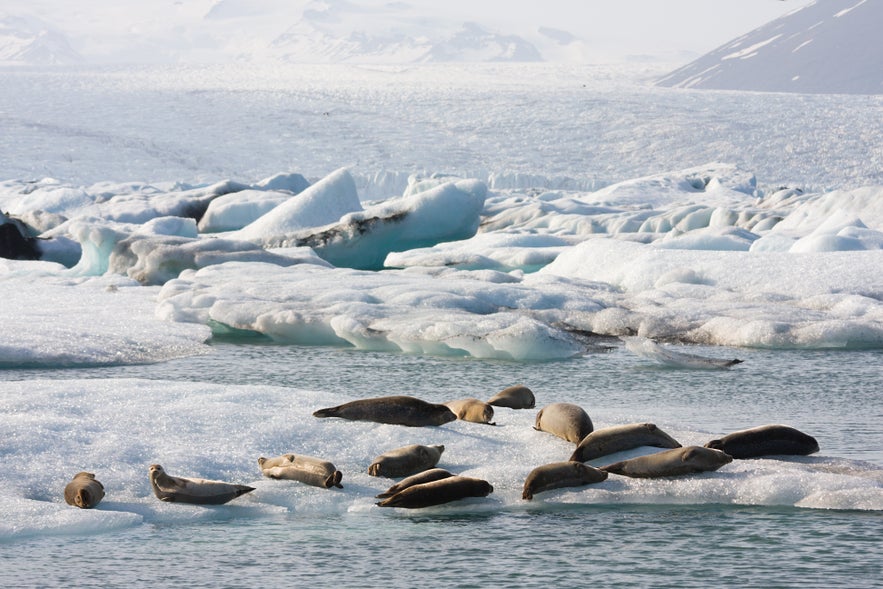 For a unique seal-watching experience, head to Jokulsarlon, Iceland’s most famous glacial lagoon. Here, seals weave effortlessly between floating icebergs, diving beneath the surface in search of fish.
For a unique seal-watching experience, head to Jokulsarlon, Iceland’s most famous glacial lagoon. Here, seals weave effortlessly between floating icebergs, diving beneath the surface in search of fish.
This location offers some of the most picturesque wildlife encounters in the country, especially during the winter months when seals are more active in the lagoon’s icy waters.
Visitors can spot seals from the shore or take a boat tour for a closer look at these graceful swimmers. Just across the road, Diamond Beach — where ice chunks from the lagoon wash up on the black sand — also provides occasional sightings of seals resting on the shore.
Other Coastal Areas: Hidden Gems for Seal Watching in Iceland
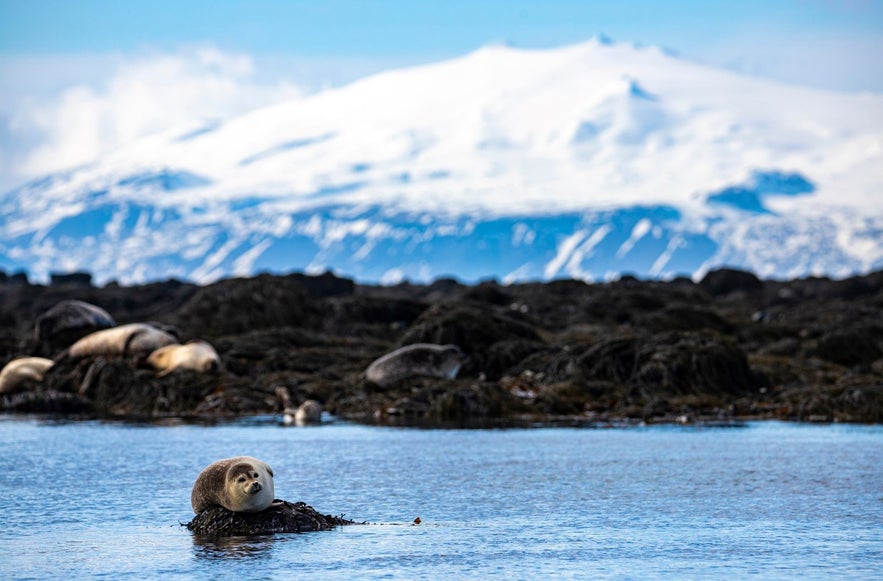 Beyond the well-known hotspots, seals can be found in several other locations along Iceland’s diverse coastline:
Beyond the well-known hotspots, seals can be found in several other locations along Iceland’s diverse coastline:
-
Snaefellsnes Peninsula: Seals are often seen near Ytri-Tunga Beach, a golden-sand shoreline that contrasts beautifully with Iceland’s usual black-sand beaches.
-
Westfjords: The remote fjords offer occasional sightings, especially in calmer coves and sheltered bays.
-
South Coast: Though less common, seals sometimes haul out on quieter stretches of sand along the South Coast, particularly near Dyrholaey.
-
Reykjanes Peninsula: Closer to Reykjavik, this area provides occasional seal sightings for those not venturing far from the capital.
You might find yourself in the seal-watching stronghold of Vatnsnes, marveling at Jokulsarlon’s icy waters, or stumbling upon seals in unexpected places. Wherever you go, Iceland offers an unforgettable chance to witness these charming marine mammals in their natural environment.
Types of Seals in Iceland: A Guide to the Species You Can Spot
Iceland’s coastal waters are home to a variety of seal species, making it a prime spot for wildlife watchers. While harbor and grey seals are the most commonly spotted, they’re far from the only ones that visit Icelandic shores.
Harbor Seals
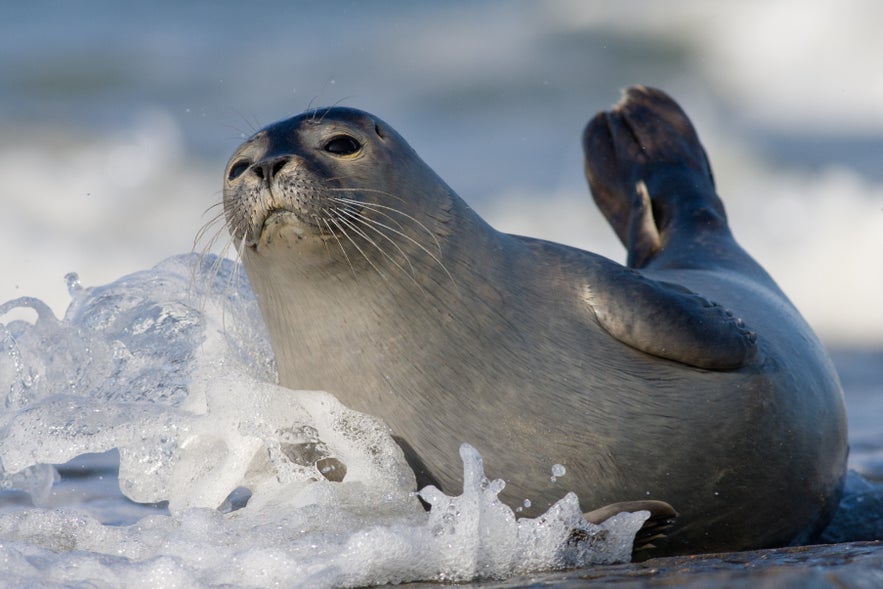 Easily recognizable with their sleek coats and playful behavior, harbor seals are the most common species around Iceland. You’ll find them in large numbers on the Vatnsnes Peninsula.
Easily recognizable with their sleek coats and playful behavior, harbor seals are the most common species around Iceland. You’ll find them in large numbers on the Vatnsnes Peninsula.
They can also be seen basking on rocks or popping their heads above water around Ytri Tunga Beach on the Snaefellsnes Peninsula and near Jokulsarlon Glacier Lagoon in the southeast.
Grey Seals
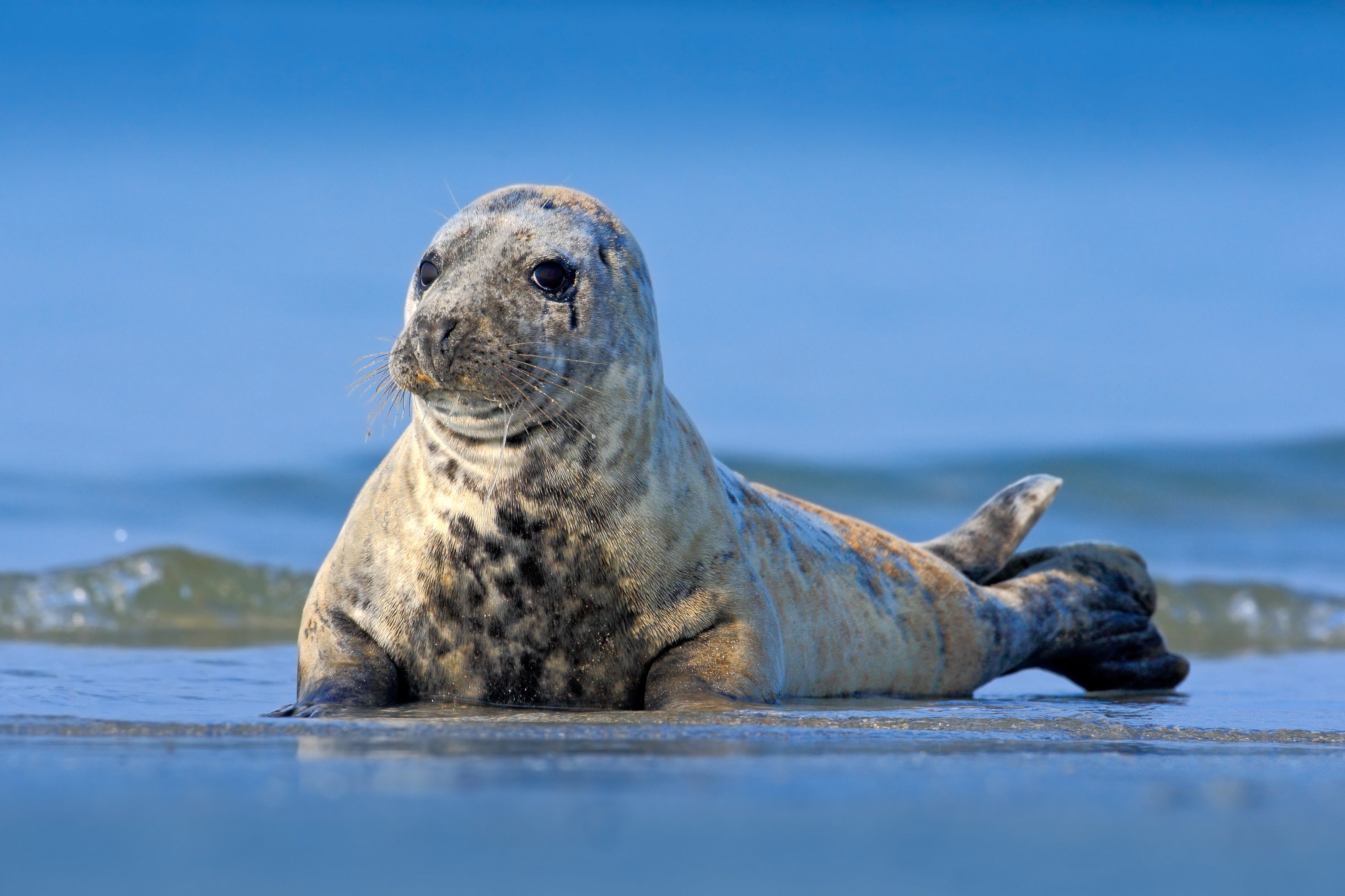 Larger and more robust than harbor seals, grey seals are known for their long, dog-like snouts and mottled grey coats that range from light silver to dark charcoal.
Larger and more robust than harbor seals, grey seals are known for their long, dog-like snouts and mottled grey coats that range from light silver to dark charcoal.
They prefer quieter, less disturbed areas and can often be found near Latrabjarg Cliffs in the Westfjords. You'll also spot them along the remote shores of North Iceland and in rocky coves along the Snaefellsnes Peninsula.
Unlike harbor seals, which tend to stick close to shore, grey seals are strong swimmers and will venture farther out to sea to hunt.
Harp Seals
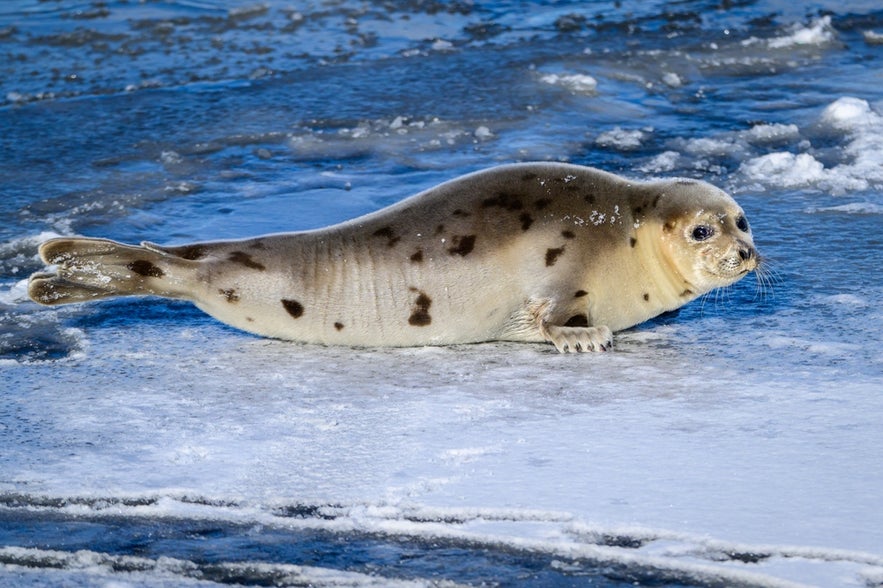 These striking seals are known for their silvery white coats with distinctive black harp-shaped markings along their backs, which become more defined as they mature. Juveniles, called “whitecoats,” have fluffy white fur, making them even more eye-catching against the blue Atlantic Ocean.
These striking seals are known for their silvery white coats with distinctive black harp-shaped markings along their backs, which become more defined as they mature. Juveniles, called “whitecoats,” have fluffy white fur, making them even more eye-catching against the blue Atlantic Ocean.
They are mostly seen along Iceland’s northern coast, especially in colder months when they migrate south from Arctic waters.
Bearded Seals
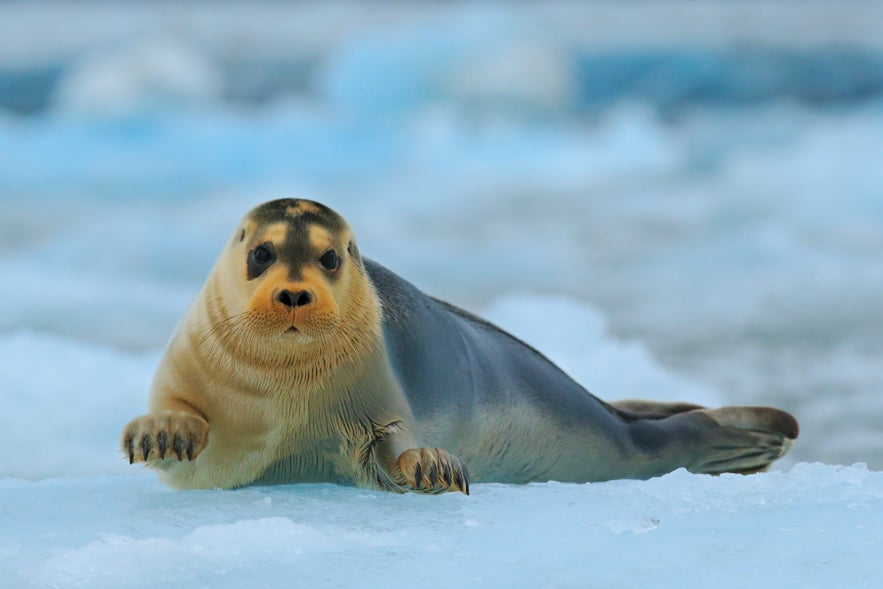 Named for their long, thick whiskers that curl when dry, bearded seals have a stocky build and a silver-grey coat. They often show a reddish-brown tinge around their faces due to iron-rich sediments in the water. These deep divers prefer icy habitats and are occasionally spotted near ice-filled fjords in the Eastfjords and along northern coast areas.
Named for their long, thick whiskers that curl when dry, bearded seals have a stocky build and a silver-grey coat. They often show a reddish-brown tinge around their faces due to iron-rich sediments in the water. These deep divers prefer icy habitats and are occasionally spotted near ice-filled fjords in the Eastfjords and along northern coast areas.
Unlike other seals, bearded seals are known for their haunting, melodic underwater vocalizations, which they use to communicate and attract mates.
Hooded Seals
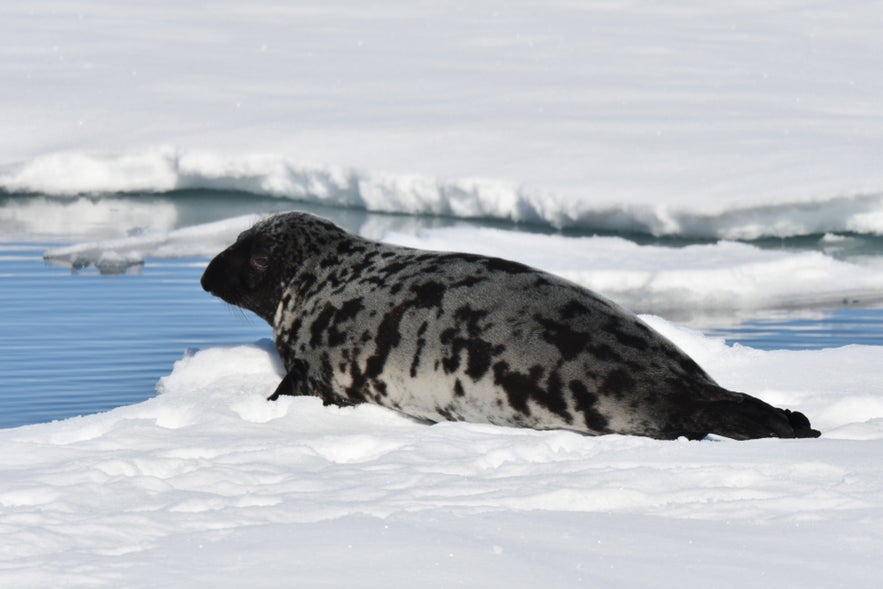 One of the most unusual-looking seals, hooded seals get their name from the inflatable black nasal sac (or “hood”) that males puff up like a balloon during mating season. Their sleek, silver-grey coats are often marked with dark spots.
One of the most unusual-looking seals, hooded seals get their name from the inflatable black nasal sac (or “hood”) that males puff up like a balloon during mating season. Their sleek, silver-grey coats are often marked with dark spots.
Though rare in Iceland, they are occasionally spotted in remote northern and eastern coastal waters, especially in colder months.
Ringed Seals
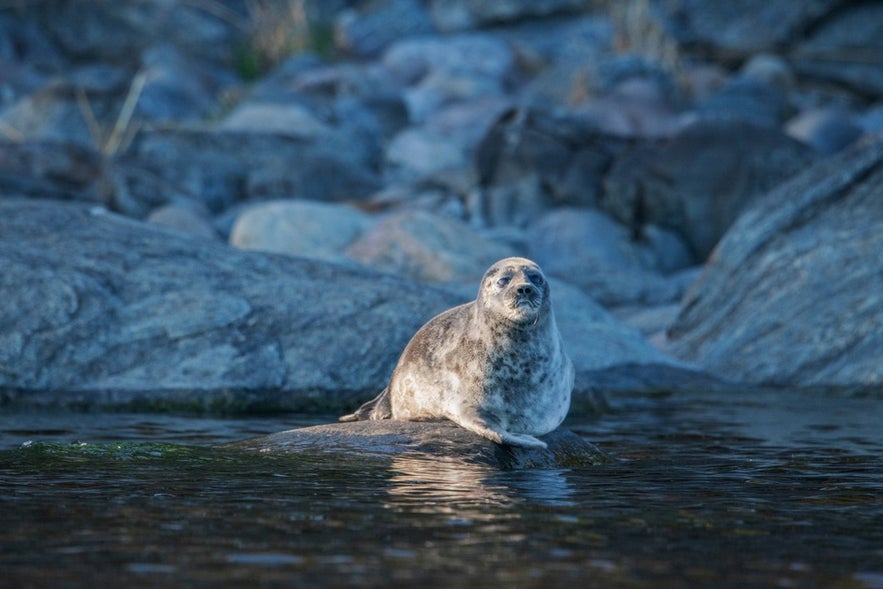 The smallest and one of the most elusive Arctic seals, ringed seals have dark grey coats covered in distinctive lighter rings, giving them their name. These seals prefer icy environments and are typically found in Iceland’s far north and east, though sightings are uncommon.
The smallest and one of the most elusive Arctic seals, ringed seals have dark grey coats covered in distinctive lighter rings, giving them their name. These seals prefer icy environments and are typically found in Iceland’s far north and east, though sightings are uncommon.
They are excellent divers, capable of staying underwater for up to 45 minutes.
Each species has its own unique traits, but all are fascinating to watch in their natural habitat. Whether you’re watching them hunt, swim, or simply lounging in the sun, each encounter provides a glimpse into the serene yet vibrant world of Icelandic marine life.
Seals in Icelandic Culture — Myth, Folklore, and Tradition
Seals have long held a special place in Icelandic culture. To the early settlers of Iceland, seals were both a valuable resource and a source of mystery. They were creatures that thrived in the cold northern waters, yet seemed to possess an almost human-like presence.
Selkies: The Shape-Shifting Seal Folk
One of the most well-known pieces of Icelandic folklore revolves around selkies, mythical beings that could shed their seal skins to take human form.
Legends tell of fishermen or farmers discovering a beautiful woman’s seal skin on the shore, stealing it to prevent her from returning to the sea, and taking her as a wife. Though she might live among humans for years and even bear children, the moment she found her hidden skin, she would return to the ocean without looking back.
These stories, often bittersweet, reflect the deep bond — and occasional conflict — between humans and nature in Icelandic tradition.
The Mythical Role of Seals in Icelandic Culture and Folklore
In some Icelandic folktales, seals were thought to be the spirits of drowned sailors or supernatural beings watching over the sea. Their presence near the shore was sometimes interpreted as a sign of changing tides, literal and metaphorical.
For fishermen, spotting a seal before setting sail could be seen as either a good omen or a warning, depending on the circumstances.

Photo by Angel Luciano
The Historic Role of Seals in Icelandic Survival
Beyond folklore, seals were historically vital to Icelanders’ survival. For centuries, coastal communities relied on them for food, oil, and clothing. Seal blubber was used for oil lamps, and their skins were crafted into durable clothing and shoes, especially before the widespread use of imported materials.
Even today, while seal hunting has significantly declined, museums and cultural centers across the country acknowledge the historic role of seals in Iceland’s survival.
- See also: Folklore in Iceland and History of Iceland
When To See Seals in Iceland: A Guide to Seasonal Patterns and Behavior

Photo by Pascal Mauerhofer
Seals may seem like lazy sunbathers when spotted lounging on Iceland’s shores, but beneath the surface, they are agile hunters and social creatures.
Seals are visible year-round, but their behavior is often informed by the weather, season, and even tide. No matter the season, low tide is usually the best for watching the curious creatures interact.
From their expert foraging skills to their tender pupping season, here’s a deeper look at how seals behave throughout the year and what you can expect to see.
Seal Diet and Hunting Habits in Icelandic Waters
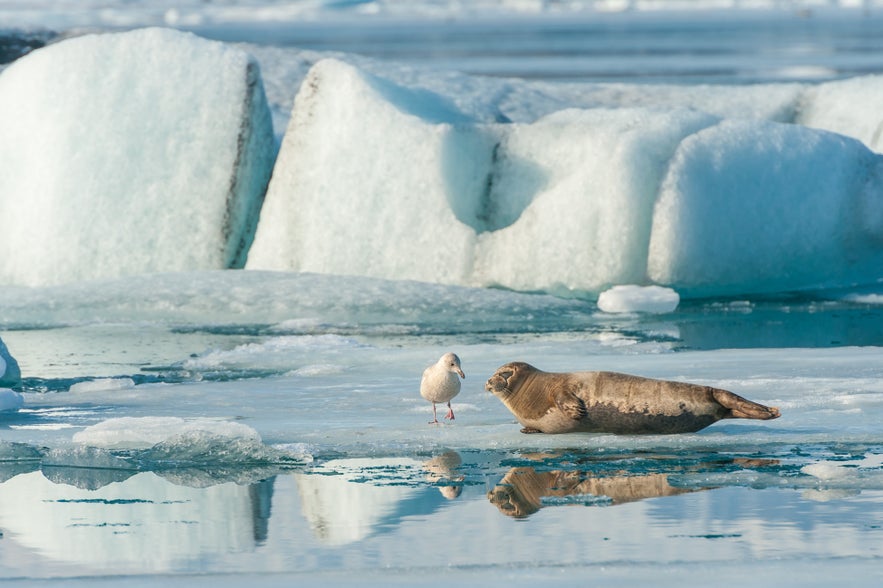 Beneath the waves, seals are sleek, skillful hunters, using their sensitive whiskers to detect the slightest movements of fish in the water. Their diet depends on species and availability, but common meals include cod, herring, and capelin.
Beneath the waves, seals are sleek, skillful hunters, using their sensitive whiskers to detect the slightest movements of fish in the water. Their diet depends on species and availability, but common meals include cod, herring, and capelin.
While harbor and grey seals are opportunistic feeders, snatching up anything from fish to crustaceans, deeper-diving species like hooded seals prefer redfish and squid. Bearded seals, true to their bottom-dwelling nature, use their whiskers to feel along the seabed for shellfish and flatfish.
Seals are built for the hunt — many can hold their breath for up to 30 minutes, diving deep beneath the waves to ambush prey. They twist and turn through the water with ease, surprising fish before they have a chance to escape. Their presence helps maintain a healthy balance in Iceland’s marine ecosystem, preventing certain fish species from overpopulating.
Breeding Seasons of Icelandic Seals
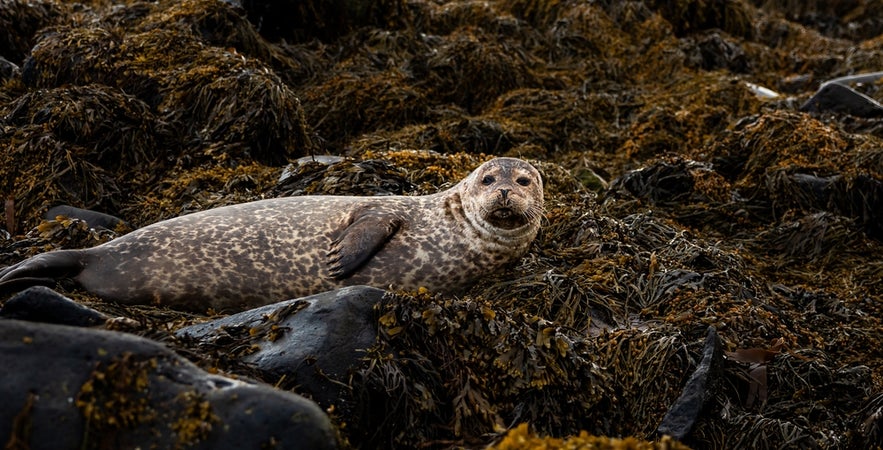
Breeding and pupping seasons vary by species, but one thing remains constant — mothers fiercely protect their young during this vulnerable time.
-
Harbor Seals: Give birth between May and July, favoring the sheltered beaches and rocky shores of Vatnsnes and Snaefellsnes for pupping.
-
Grey Seals: Pup in autumn (September to November) on remote sandbanks and isolated rocky islands, where their white-coated pups stay for weeks before shedding their fur.
-
Harp Seals: Famous for their fluffy white pups, which are born on floating sea ice between late February and March in Arctic waters.
-
Bearded and Ringed Seals: Rely on ice formations for pupping, making sightings in Iceland rare.
-
Hooded Seals: Have a short nursing period of only 4-5 days, one of the fastest of any seal species, with pups born between March and April in colder waters.
During pupping season, seals become more territorial and cautious, making it even more important for visitors to keep a respectful distance when observing them.
Fun and Fascinating Behaviors of Seals in Iceland
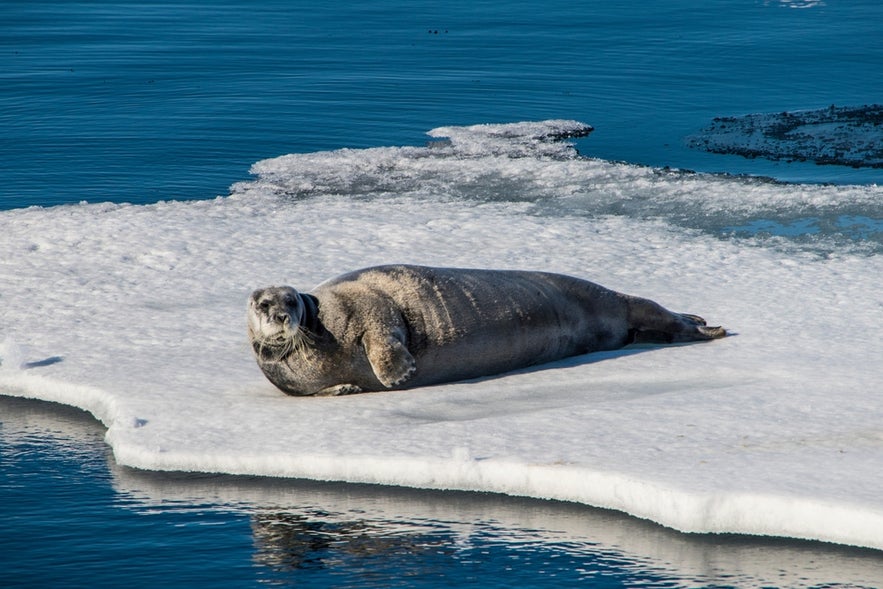 Seals are incredibly playful and social. They often pop their heads above water, known as “spy-hopping,” observing their surroundings with as much curiosity as the people watching them.
Seals are incredibly playful and social. They often pop their heads above water, known as “spy-hopping,” observing their surroundings with as much curiosity as the people watching them.
In calm coves and harbors, seals can be seen bobbing on the surface, twisting in the waves, or rolling onto their backs to bask in the sun. On land, they wave their flippers in the air, either as a means of cooling off or simply out of habit.
Some species, like bearded seals, are surprisingly vocal, filling the icy waters with melodic calls that can carry on for miles. Meanwhile, young pups will let out soft cries when separated from their mothers.
In the water, their agility shines — seals will leap and dive in a behavior called “porpoising,” resembling dolphins as they propel themselves forward. Though playful, seals remain cautious. If they sense a threat, they’ll slip back into the water in an instant.
To witness these behaviors naturally, it’s essential to observe them quietly and from a respectful distance.
Seal Watching Tours & Accessibility — Exploring Iceland’s Coastal Wonders
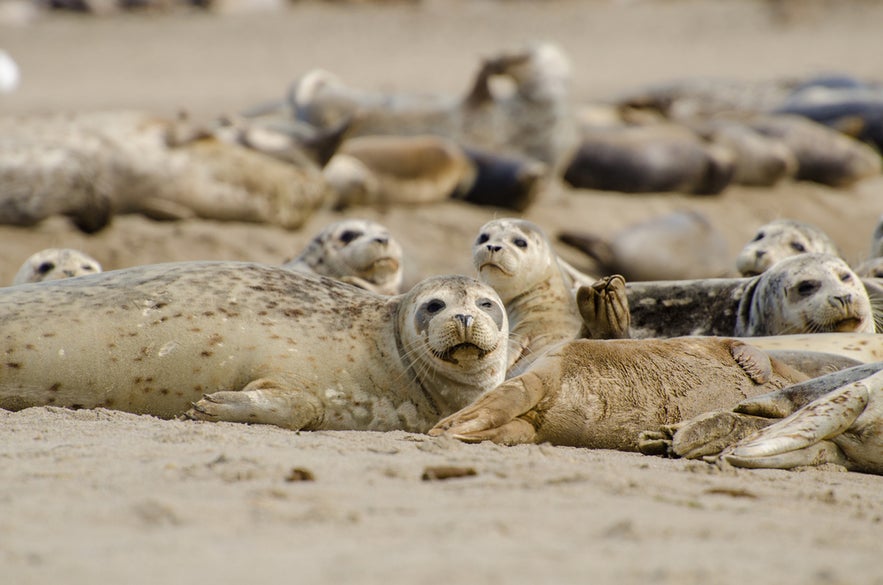 Whether you prefer the insight of a guided tour or the freedom of exploring on your own, Iceland offers incredible opportunities to witness seals in their natural habitat. From expert-led excursions to easily accessible coastal viewpoints, there’s an option for every traveler to enjoy seal watching.
Whether you prefer the insight of a guided tour or the freedom of exploring on your own, Iceland offers incredible opportunities to witness seals in their natural habitat. From expert-led excursions to easily accessible coastal viewpoints, there’s an option for every traveler to enjoy seal watching.
Guided Seal-Watching Tours in Iceland
Joining a guided tour is one of the best ways to see seals while learning about their behavior, habitats, and conservation. Many tours ensure visitors maintain a respectful distance while offering fascinating insights into these incredible marine mammals.
Some top Iceland seal-watching experiences include:
-
Jokulsarlon Glacier Lagoon Amphibian Boat Tour: This 30–40 minute boat tour lets visitors glide among floating icebergs while spotting seals swimming or resting on the ice. Guides provide insights into the lagoon’s formation and its wildlife.
-
Whale Watching Tour in Breidafjordur Bay: While primarily a whale-watching tour from Olafsvik, this excursion also offers chances to see seals lounging on the coastline, along with a variety of seabirds.
Independent Seal Watching in Iceland
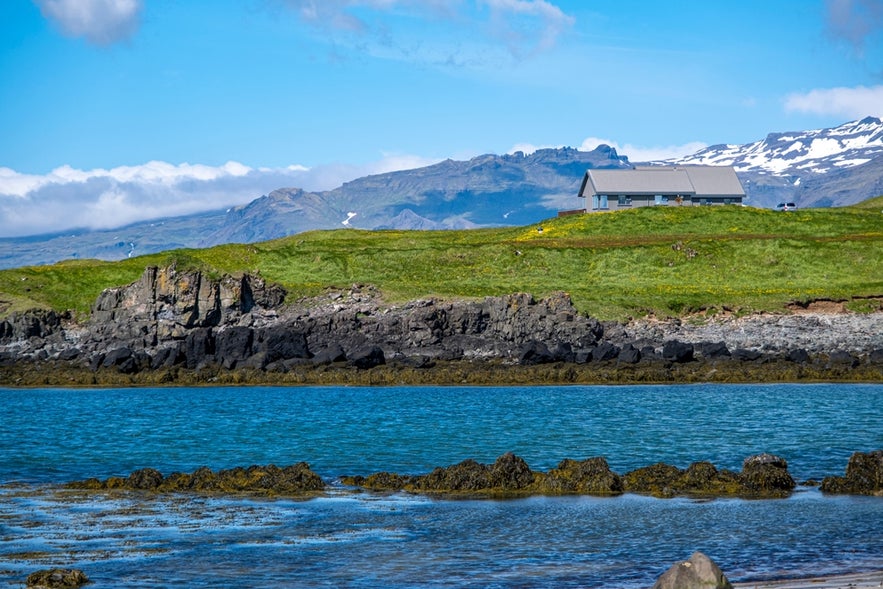 For those who prefer to explore at their own pace, many coastal areas offer excellent opportunities for independent seal watching.
For those who prefer to explore at their own pace, many coastal areas offer excellent opportunities for independent seal watching.
The Vatnsnes Peninsula is widely regarded as Iceland’s top spot for seeing seals, with locations like Illugastadir and Hvitserkur providing reliable sightings. Other great self-guided locations include Ytri Tunga Beach on the Snaefellsnes Peninsula and the shores around Jokulsarlon Glacial Lagoon.
For a self-guided experience, consider these key locations:
-
Vatnsnes Peninsula & Icelandic Seal Center: Hvammstangi’s Seal Center provides educational exhibits before visitors head out to see seals in the wild at Illugastadir and Hvitserkur.
-
Ytri Tunga Beach: Known for its resident seal colony, this beach offers one of the most reliable self-guided seal-watching experiences in Iceland.
Iceland’s Most Accessible Seal-Watching Locations
 Iceland’s diverse landscapes offer a host of seal-watching opportunities. While some locations require trekking across rugged terrain, several spots cater to visitors of all mobility levels.
Iceland’s diverse landscapes offer a host of seal-watching opportunities. While some locations require trekking across rugged terrain, several spots cater to visitors of all mobility levels.
-
Icelandic Seal Center in Hvammstangi: This is an excellent starting point, featuring accessible exhibits that provide valuable insights before heading out to see seals in the wild.
-
Jokulsarlon Glacial Lagoon: It has well-maintained pathways near the parking area that allow visitors to observe seals lounging on icebergs without the need for strenuous walking.
-
Ytri Tunga Beach: While the shoreline itself is rocky, seals can often be spotted from vantage points that require minimal effort to reach.
-
Vatnsnes Peninsula: Some viewing areas, like Illugastadir, are accessible by car, allowing visitors to enjoy seal sightings without long hikes.
Many guided tours can accommodate different mobility needs, making it possible for everyone to experience Iceland’s incredible marine wildlife.
Seal Watching Guidelines & Safety Precautions
 Seeing seals in the wild is an unforgettable experience, but it’s essential to observe them in a way that respects their natural behavior and your own safety. Seals may appear relaxed and curious, but they are still wild animals that can be easily disturbed — or even feel threatened — by human activity.
Seeing seals in the wild is an unforgettable experience, but it’s essential to observe them in a way that respects their natural behavior and your own safety. Seals may appear relaxed and curious, but they are still wild animals that can be easily disturbed — or even feel threatened — by human activity.
Follow these guidelines to ensure a responsible and safe seal-watching experience.
Responsible Seal Watching in Iceland: What To Do and What To Avoid
Seals spend much of their time resting on land to conserve energy, warm up, and care for their young. Disturbing them can cause stress, disrupt their natural rhythms, or scare them back into the water. To minimize your impact, keep these best practices in mind:
-
Maintain a Safe Distance: Stay 230–330 feet (70–100 meters) away from seals whenever possible. If they start looking at you frequently, shifting position, or retreating into the water, you're too close.
-
Use a Zoom Lens: If you want a close-up photo, bring a camera with a zoom lens instead of approaching the animals.
-
Keep Noise Levels Low: Seals have excellent hearing and can be startled by sudden noises, so keep voices down and avoid unnecessary movement.
-
Never Feed Seals: Human food is harmful to them, and feeding wildlife can alter their natural behaviors in dangerous ways.
-
Leave Pets at Home: Dogs and other animals can stress or even chase seals, so it’s best not to bring them along on seal-watching outings.
Personal Safety — How To Stay Safe While Watching Seals in Iceland
Iceland’s coastal areas can be unpredictable, with slippery rocks, strong tides, and unstable ground. When searching for seals, always prioritize your safety and consider the following reminders:
-
Be Cautious on Rocky Shores: Wet rocks and seaweed-covered surfaces can be extremely slippery. Walk carefully and wear sturdy footwear with ankle support.
-
Stay on Designated Paths: Many seal-watching locations have marked trails to protect both visitors and wildlife.
-
Be Aware of Changing Tides: Some seal habitats are near tidal zones, meaning water levels can shift rapidly. Don’t get caught on a sandbar or cut off from shore.
-
Dress Appropriately: Iceland’s weather can change quickly. Wear warm, waterproof layers, especially if you’re visiting a remote seal-watching site.
What To Do if You See a Stranded or Injured Seal
It’s not uncommon to see seals resting on land for extended periods — this is normal behavior and doesn’t necessarily mean they need help. However, if a seal appears injured, weak, or stranded in an unusual location (like far inland or on a road), here’s what to do:
-
Contact Local Authorities: The best course of action is to reach out to the Icelandic Seal Center or the Marine and Freshwater Research Institute for guidance. In some cases, local wildlife rescue organizations may also assist. When in doubt, never hesitate to call:
-
Icelandic Seal Center: +354 451 2345
-
Marine and Freshwater Research Institute: +354 575 2000
-
The Iceland emergency service (112) can also be contacted for any wild animal in need.
-
-
Do Not Attempt To Move the Seal: Seals can become aggressive if approached, and handling them improperly can do more harm than good.
-
Keep Your Distance and Observe: If you're unsure about the seal's condition, take note of its location, behavior, and any visible injuries before reporting it.
By following these simple guidelines, you can enjoy a magical seal-watching experience while helping to protect these incredible marine mammals.
Seal Conservation Efforts in Iceland
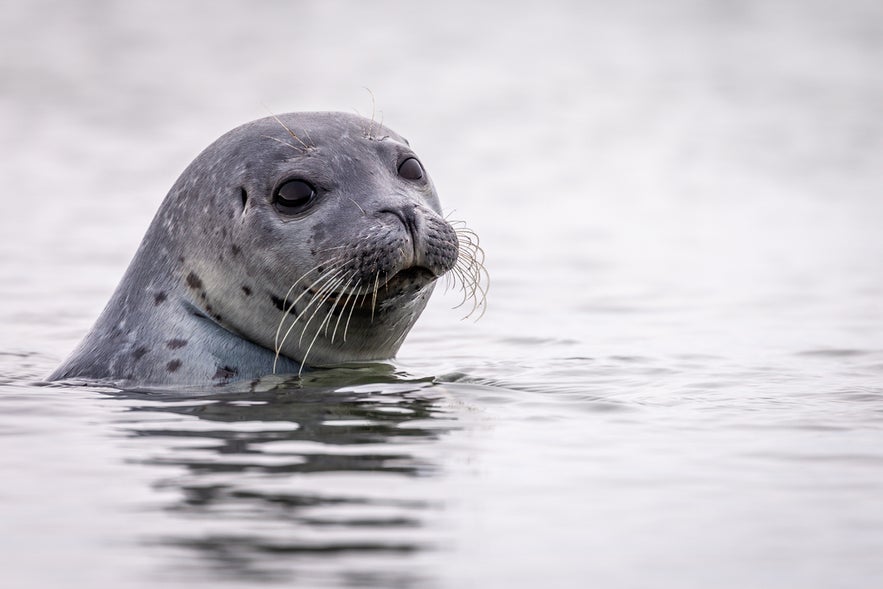
Seals in Iceland are an integral part of the marine ecosystem, but like many wildlife species, they face increasing challenges due to climate change, human activity, and habitat disruption. Thankfully, conservation efforts across the country are working to protect these fascinating animals and ensure their survival for generations to come.
Threats to Iceland’s Seal Population
Iceland’s seal populations are under pressure from both natural and human-made threats.
Climate change is reshaping the marine environment, affecting the fish stocks that seals rely on for food. As ocean temperatures rise and sea ice diminishes, the delicate balance of the ecosystem is shifting, making it harder for seals — especially migratory species — to thrive.
Beyond environmental changes, human activity also plays a role. Accidental entanglement in fishing nets, known as bycatch, remains a significant threat, often leading to injuries or fatalities.
In areas where tourism has increased, seals face disturbances from visitors who unknowingly get too close, causing stress and disrupting their natural behaviors.
Although commercial seal hunting has largely been phased out, its historical impact lingers, with some species still recovering from population declines.
Despite these challenges, Iceland has made significant strides in seal conservation, with dedicated research institutions and sustainable tourism initiatives leading the charge.
Ongoing Seal Conservation Initiatives in Iceland
Several organizations and research institutions are actively working to monitor, study, and protect seal populations in Iceland:
-
Icelandic Seal Center: Based in Hvammstangi, this research hub studies seal populations, promotes sustainable tourism, and educates visitors on conservation.
-
Marine and Freshwater Research Institute: Conducts scientific research on marine ecosystems, including seal population trends and health assessments.
-
Green Key Certification: Sustainable tourism initiatives, such as the Icelandic Seal Center’s Green Key certification, help promote eco-friendly wildlife observation practices.
-
Virtual Reality Conservation Efforts: Innovative projects, including a VR experience, allow visitors to engage with seal habitats and conservation efforts without disturbing wildlife.
How You Can Help Protect Iceland’s Seals
As a visitor, you have the power to contribute to seal conservation simply by being mindful of your actions.
-
Choose Ethical Tour Operators: Prioritizing wildlife protection is one of the best ways to ensure that your seal-watching experience has a positive impact.
-
Maintain a Respectful Distance: This is an important practice when observing seals in the wild. Additionally, you must follow established guidelines to help prevent unnecessary disturbances.
-
Support Research and Conservation Organizations: This can include donations, visiting educational centers, or spreading awareness, which also makes a difference.
-
Reduce Plastic Waste and Respect Protected Areas: Even small actions help safeguard the delicate coastal ecosystems where seals thrive.
By adopting responsible tourism practices, every visitor can play a role in preserving Iceland’s incredible marine life for the future.
FAQs on Seal Watching in Iceland

Photo by Pascal Mauerhofer
Because seals appear playful, like many domesticated animals, visitors are filled with questions and are often tempted to get close to the animals. Here are some answers to common questions, as well as some safety tips for brave animal lovers.
Can I pet and feed the seals?
No, seals are wild animals. While they may appear approachable, feeding or attempting to pet them can disrupt their natural behavior and harm their well-being. Always observe seals from a distance and respect their space.
Will seals attack me?
Seals are generally shy animals and will avoid human interaction if given the opportunity. However, they are still wild creatures, and it is important to maintain a safe distance. Seals may become stressed if they feel threatened, so always approach them quietly and avoid making sudden movements.
How far away should I stay from seals?
To ensure both your safety and the seals' well-being, it's recommended to stay at least 100 meters (about 328 feet) away from them. This allows you to observe without causing any stress or harm to the animals.
Are there specific seasons for seal watching in Iceland?
Yes! The best time for seal watching in Iceland is typically from April to October. During this period, seals are most active on the shores and are easier to spot. However, some species of seals can be seen year-round in certain areas.
What species of seals can I expect to see in Iceland?
Iceland is home to several species of seals, with the most commonly spotted being the harbor seal and the grey seal. The Vatnsnes Peninsula is particularly well-known for its large seal colonies, and there are other spots across the country where you can see these fascinating creatures.
Is it safe to watch seals from a boat or a guided tour in Iceland?
Yes, joining a guided boat tour is a safe and environmentally responsible way to observe seals. These tours are designed to minimize disturbances to wildlife, providing you with expert guidance while ensuring that seals are not harassed.
What should I bring for a seal-watching trip in Iceland?
When heading out to see seals, it's a good idea to bring warm, layered clothing, as Icelandic weather can be unpredictable. Waterproof boots and a camera with a zoom lens will also be useful. Always remember to pack out everything you bring with you to keep the environment pristine.
Can I spot seals in Reykjavik?
While Reykjavik is a bustling city, you can still spot seals along its coastline, particularly in areas like the Grotta Lighthouse or the nearby beaches. For more abundant seal sightings, however, head to regions like the Vatnsnes Peninsula or the Jokulsarlon Glacier Lagoon.
What is being done to protect seals in Iceland?
Iceland has made significant efforts in seal conservation. Organizations like the Icelandic Seal Center have worked hard to increase public awareness and protect seal populations. Many seal-watching locations are certified with the Green Key, a global eco-label that promotes sustainable tourism and conservation practices.
Can I take part in seal research or conservation efforts?
Yes! If you're passionate about seal conservation, several organizations in Iceland offer volunteer opportunities or even experiences that contribute to research efforts. The Icelandic Seal Center, for example, is a great place to learn more about seals and participate in conservation initiatives.
Embrace the Magic of Seal Watching in Iceland
Seal watching in Iceland offers a unique chance to connect with nature, as you observe these remarkable marine mammals in their pristine, untouched habitats.
You might be captivated by the playful antics of harbor seals or the elusive beauty of grey seals. The mesmerizing environment of Jokulsarlon adds to the experience, and Iceland's coastline provides endless opportunities for wildlife enthusiasts.
- See also: Wildlife and Animals in Iceland
- Learn more: 6 Facts You Didn’t Know about Icelandic Water
- Check out: Sustainable Tourism in Iceland
While the opportunity to encounter seals is a thrilling experience, it’s important to remember the responsibility we share in protecting these creatures. By adhering to ethical observation practices and supporting conservation efforts, we can ensure that future generations will have the same awe-inspiring encounters with Iceland’s whiskered locals.
Ready to witness seals in their natural habitat? Iceland’s rugged shores await, offering a memorable wildlife adventure that combines breathtaking scenery with the thrill of discovery. Comment below to tell us about your seal-watching experiences.

